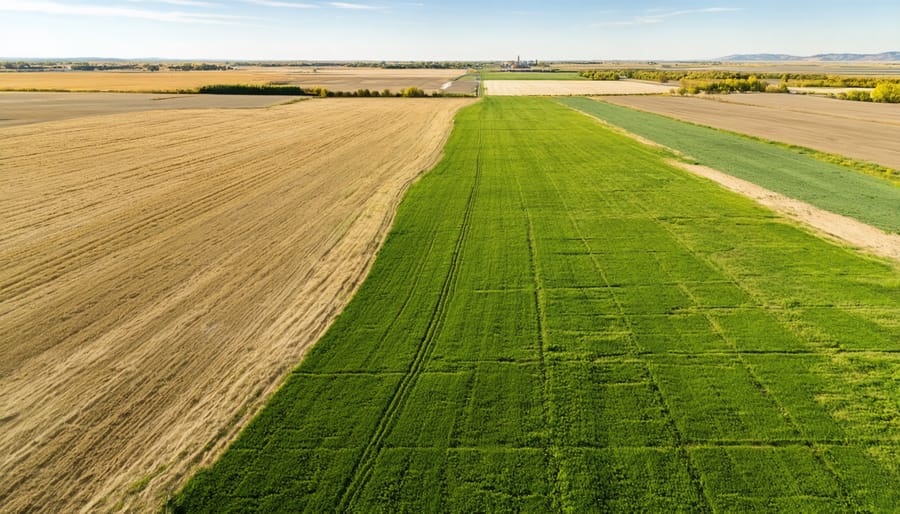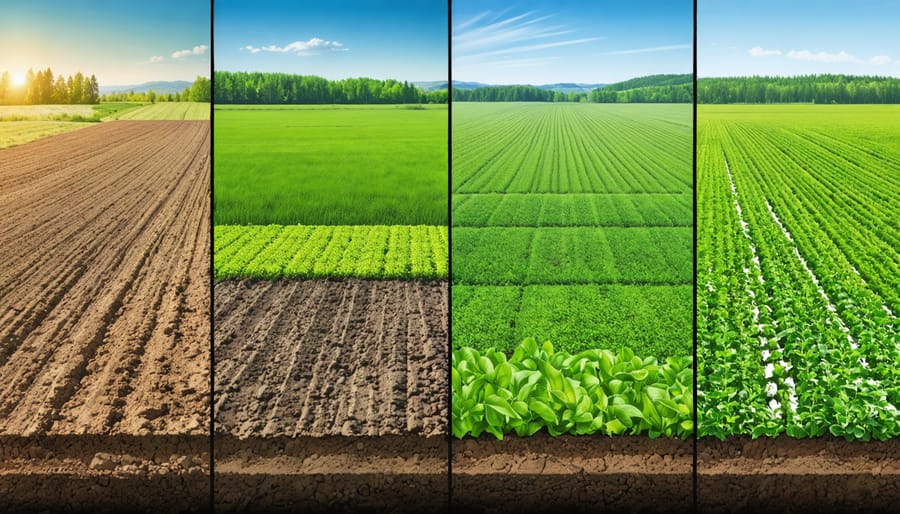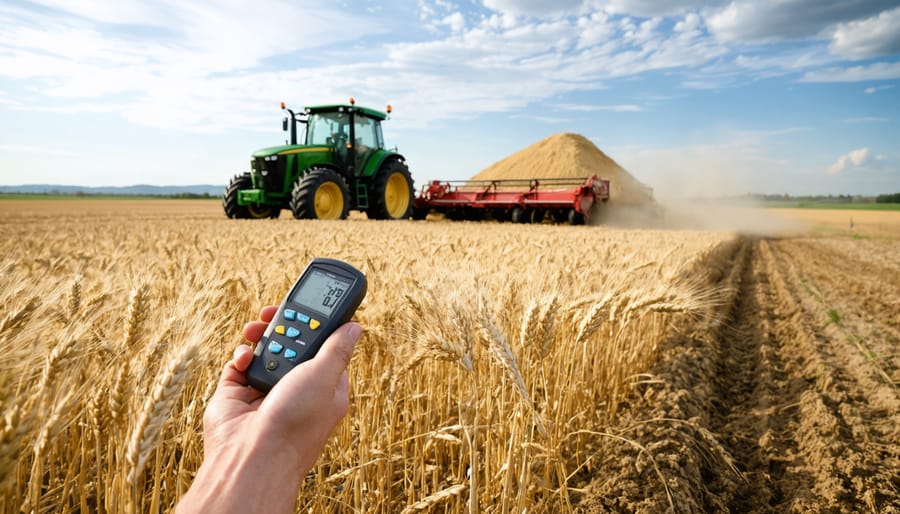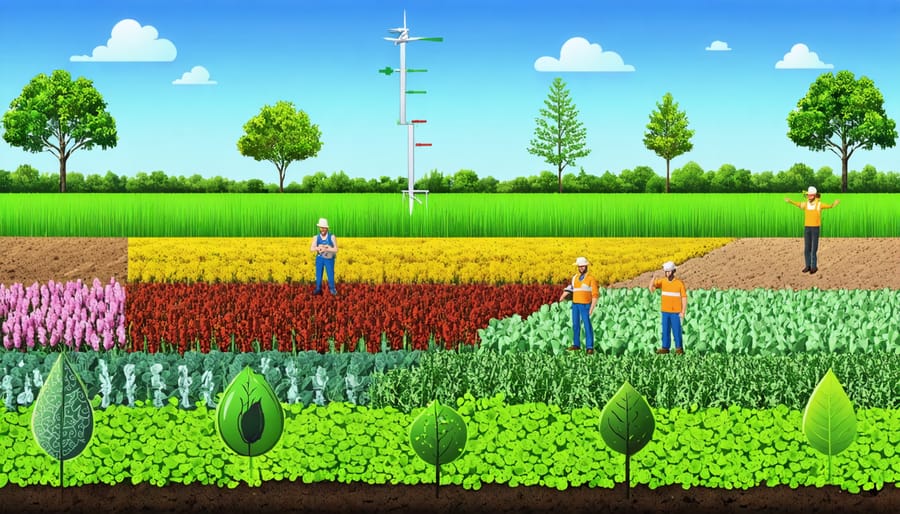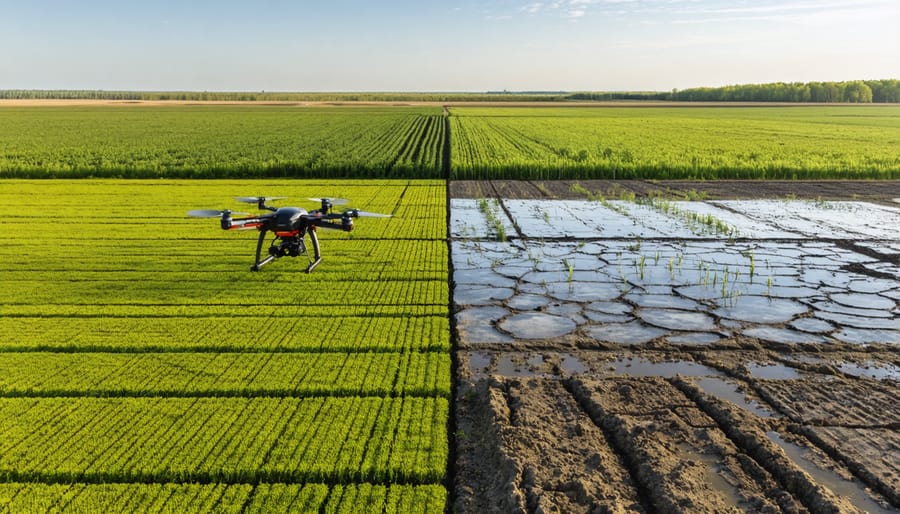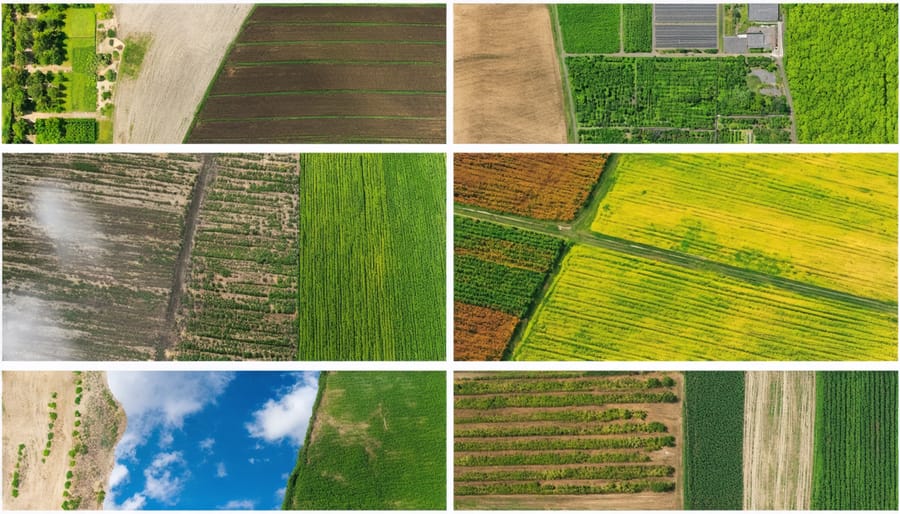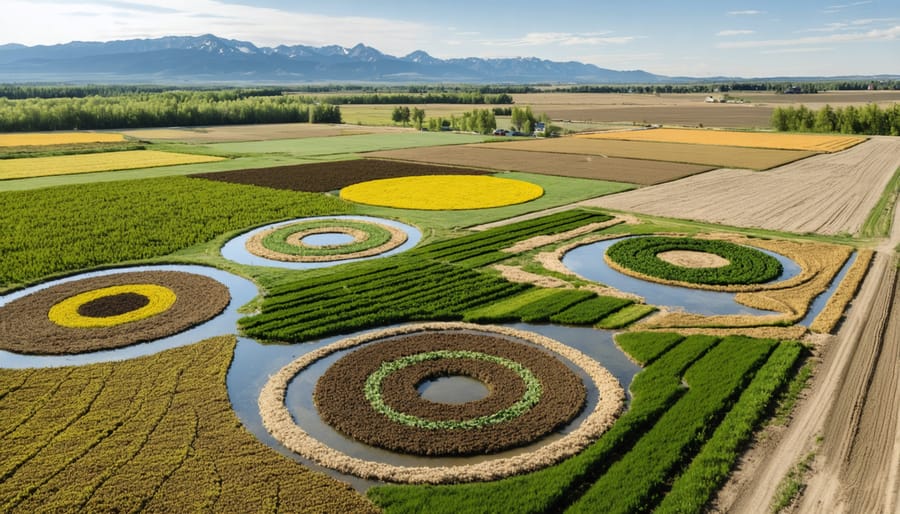Plant deep-rooted native grasses along field margins to create natural barriers that prevent topsoil loss while supporting climate-resilient farming practices. Implement contour farming techniques across sloped terrain, following natural elevation lines to reduce water runoff by up to 50% during heavy rainfall events. Install strategically placed windbreaks using Alberta-hardy trees and shrubs to shield vulnerable cropland from prevailing winds that contribute to soil degradation.
Prairie farmers lose an estimated 1.6 million tonnes of valuable topsoil annually through erosion—but proven control methods can protect this essential resource while improving farm productivity. Modern erosion control combines traditional knowledge with innovative technologies, offering Alberta producers practical solutions that work within existing operations and local climate conditions.
This comprehensive guide examines field-tested techniques that safeguard soil health, boost crop yields, and strengthen long-term farm sustainability. Drawing from successful implementations across central and southern Alberta, we’ll explore cost-effective strategies that deliver measurable results for operations of any size.
Understanding Alberta’s Unique Erosion Challenges
Wind Erosion: The Prairie Problem
Alberta’s prairie landscape faces unique challenges when it comes to wind erosion, particularly during the dry seasons. Our vast open fields, combined with strong chinook winds, create perfect conditions for topsoil displacement. Light-textured soils in regions like Southern Alberta are especially vulnerable, with some areas losing up to 6 tonnes of topsoil per hectare annually during severe wind events.
The risk factors intensify during early spring and late fall when fields are typically bare and rainfall is minimal. Fields with less than 30% ground cover are particularly susceptible to wind damage. While implementing drought-resistant farming strategies has helped many producers, wind erosion remains a significant concern.
Local studies show that fields oriented perpendicular to prevailing winds experience up to 40% more soil loss than those with protective windbreaks or other wind-resistant features. The combination of our region’s climate patterns and agricultural practices means that without proper management, wind erosion can quickly transform productive farmland into degraded soil requiring years of restoration.
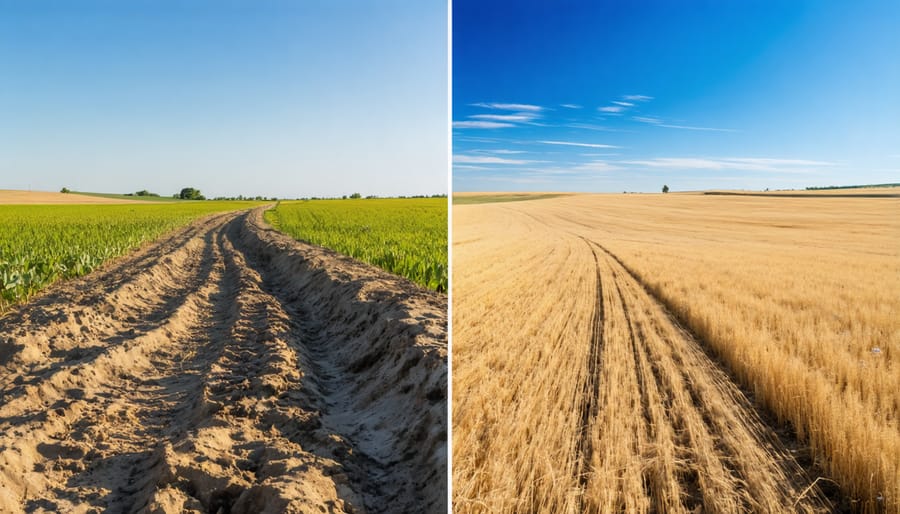
Water Erosion Hot Spots
In Alberta’s diverse agricultural landscape, certain areas are particularly vulnerable to water erosion, especially during spring snowmelt and intense summer storms. Fields with slopes greater than 2% and areas with exposed soil during critical periods typically face the highest risk. Watch for signs like small rills forming after rain events, particularly in valley bottoms and along hillsides where water infiltration rates are poor.
Common seasonal patterns include increased erosion risk during early spring when fields are bare and during June-July when heavy rainfall events are most frequent. The chinook belt in southern Alberta requires special attention, as rapid snow melting can create significant runoff issues.
Key hot spots to monitor include:
– Field entrances and exits where equipment traffic is heaviest
– Areas where slopes converge, creating concentrated water flow
– Lower field edges near water bodies
– Zones with compacted soil or poor organic matter content
– Places where crop residue has been removed or extensively grazed
Regular field walks during and after precipitation events can help identify these vulnerable areas early, allowing for targeted preventive measures before significant damage occurs.
Proven Field Solutions from Alberta Farmers
Cover Cropping Success Stories
Mike Anderson, a third-generation farmer from Lethbridge, transformed his 400-hectare wheat operation by implementing a diverse cover crop rotation. “After losing topsoil during the 2019 windstorms, I knew we needed a change,” he shares. Using a mixture of fall rye and field peas, Mike reduced soil erosion by 85% in just two growing seasons while improving his soil organic matter by 2%.
In Red Deer County, Sarah Thompson’s innovative approach combines winter wheat and hairy vetch on her 250-hectare farm. “The roots hold our soil in place during spring thaw, which used to be our biggest erosion challenge,” Sarah explains. Her success has inspired neighboring farms to adopt similar practices, creating a community-wide impact on soil conservation.
The Morrison family farm near Medicine Hat showcases the long-term benefits of cover cropping. Their decade-long commitment to using clover and barley cover crops has resulted in a 90% reduction in soil loss and a 20% increase in water retention. “We’ve cut our irrigation needs significantly,” notes Jim Morrison, “and our soil health scores improve every year.”
These success stories demonstrate how cover cropping can be adapted to various Alberta growing conditions. Local agricultural extension offices report that farms using cover crops consistently show better resilience during extreme weather events and improved yield stability over time.
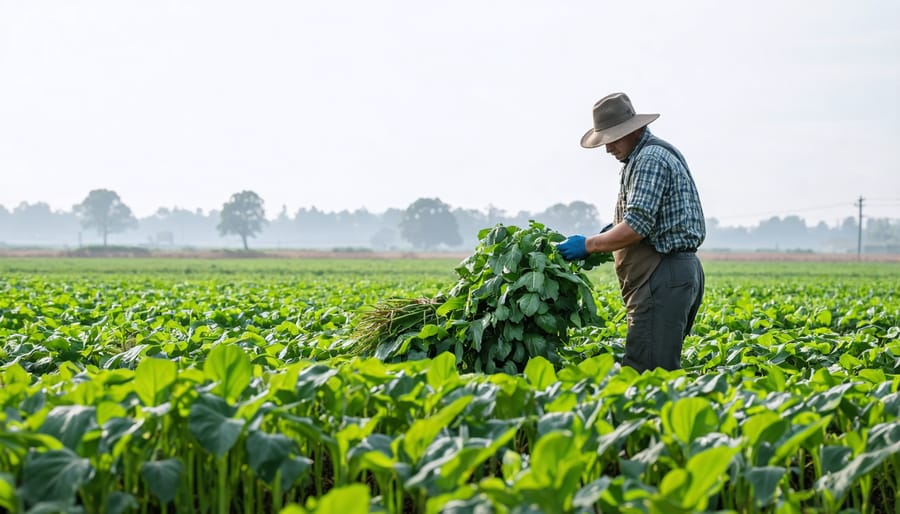
Conservation Tillage Techniques
Conservation tillage has revolutionized soil management practices across Alberta’s agricultural landscape, offering farmers effective solutions for controlling erosion while maintaining productivity. By implementing no-till farming techniques and reduced tillage methods, producers have seen remarkable improvements in soil structure and stability.
The key principle behind conservation tillage is minimizing soil disturbance while maintaining crop residue on the surface. In Alberta’s prairie region, leaving at least 30% of crop residue on fields has shown to reduce soil erosion by up to 65% compared to conventional tillage methods. This approach not only protects against wind and water erosion but also promotes beneficial soil microorganism activity.
Local farmers have reported success with various conservation tillage implements, including chisel plows and strip-till equipment. These tools allow for precise seed placement while maintaining protective residue cover. Many Alberta producers have found that switching to conservation tillage has reduced fuel costs by 40-50% and decreased labour requirements significantly.
Recent field studies in Red Deer County demonstrate that conservation tillage practices have increased organic matter content by 2-3% over five years, improving both water retention and soil structure. This improvement has proven particularly valuable during drought conditions, helping crops remain resilient through challenging growing seasons.
Implementation costs can be offset through various provincial support programs, making the transition more accessible for farmers looking to protect their soil while maintaining profitable operations.
Windbreak Strategies That Work
In Alberta’s challenging climate, well-designed windbreaks are essential for controlling soil erosion. A multi-row approach using a combination of fast-growing species like hybrid poplars and longer-lasting varieties such as white spruce has proven most effective. For immediate protection, consider planting tall wheatgrass or Russian olive as your first row, creating a dense barrier within 2-3 growing seasons.
When planning your windbreak, aim for a height of at least 10 metres and maintain a porosity of 40-60% to optimize wind reduction without creating turbulence. Space your rows 4-6 metres apart, with trees within rows planted 2-3 metres from each other. This configuration provides optimal protection for up to 20 times the windbreak’s height downwind.
Regular maintenance is crucial for windbreak success. In the first three years, control competing vegetation within a 1-metre radius of young trees and ensure adequate irrigation, particularly during dry spells. Consider installing drip irrigation systems to reduce water waste and maintain consistent soil moisture.
For enhanced effectiveness, many Alberta farmers have found success incorporating snow fences during winter months. These temporary barriers complement permanent windbreaks and help distribute snow evenly across fields, improving spring moisture retention.
Remember to protect young trees from wildlife damage using tree guards or fencing, especially during the establishment phase. Annual inspections for disease and pest issues will help maintain your windbreak’s long-term viability.
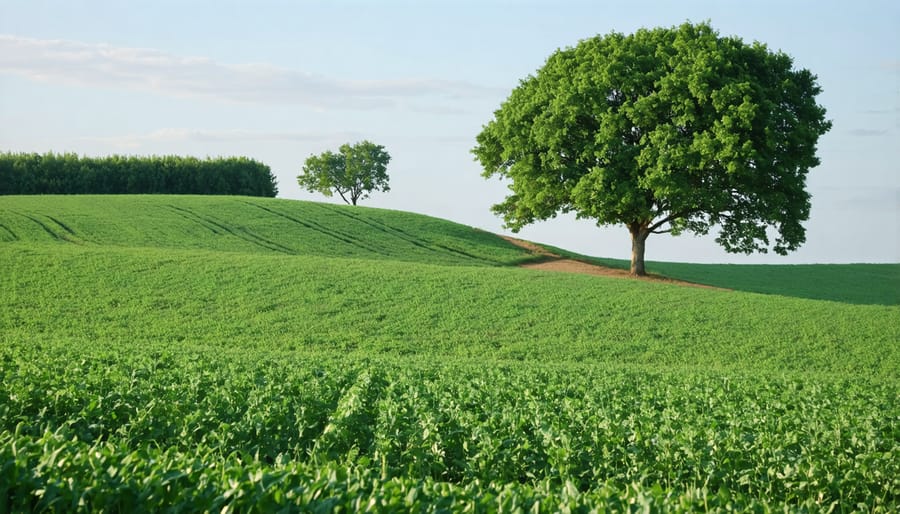
Cost-Effective Implementation
Government Support Programs
Canadian farmers have access to several government-supported programs designed to help implement effective soil erosion control measures. The Environmental Farm Plan (EFP) in Alberta offers cost-sharing opportunities of up to 70% for approved soil conservation projects, including windbreak establishment and riparian area protection.
The Canadian Agricultural Partnership (CAP) provides funding through its AgriInvest program, allowing farmers to build savings accounts with matching government contributions that can be used for erosion control investments. In Alberta, the Agricultural Service Board Grant Program specifically supports producers implementing innovative soil conservation practices.
Local Soil Conservation Districts offer technical assistance and equipment rentals at reduced rates, making it easier for farmers to implement erosion control measures without significant upfront costs. The Agriculture Financial Services Corporation (AFSC) provides low-interest loans specifically for environmental improvements, including erosion control projects.
For Indigenous farmers, the First Nations Land Management Resource Centre offers additional funding and technical support for soil conservation initiatives. The Prairie Farm Rehabilitation Administration (PFRA) legacy programs continue to provide resources and expertise for sustainable land management practices.
To access these programs, farmers can connect with their local agricultural fieldman or visit their nearest Agriculture and Agri-Food Canada office. Many of these programs also offer workshops and one-on-one consultations to help farmers develop customized erosion control strategies for their specific situations.
Return on Investment Analysis
Investing in soil erosion control methods yields significant returns for Alberta farmers, both in the short and long term. Based on local case studies, implementing basic contour farming practices costs approximately $50-75 per hectare initially but can prevent topsoil losses valued at $150-200 per hectare annually. This represents a potential return on investment of up to 167% in the first year alone.
Cover cropping, while requiring an initial investment of $100-150 per hectare for seeds and planting, typically pays for itself within two growing seasons through improved soil structure and reduced fertilizer needs. Many Alberta farmers report 15-20% increases in main crop yields after establishing regular cover cropping routines.
Conservation tillage systems, though requiring specialized equipment, show impressive long-term returns. Initial investments of $30,000-50,000 for equipment modifications can be offset by annual savings of $45-60 per hectare in fuel and labor costs. Additionally, farmers using these systems report 30-40% reductions in soil erosion-related losses.
Windbreak installation costs vary significantly, ranging from $2,000-5,000 per kilometer, but government cost-sharing programs can reduce out-of-pocket expenses by up to 50%. Studies show that properly maintained windbreaks can increase crop yields by 10-15% in protected areas while extending the productive lifespan of fields by decades.
Remember that many erosion control investments qualify for agricultural tax credits and environmental stewardship grants, further improving their financial viability.
Monitoring and Maintenance
Seasonal Checkpoints
Monitoring your soil throughout Alberta’s distinct seasons is crucial for effective erosion control. In spring, assess winter damage as snow melts, looking for exposed soil patches, new gullies, or areas where winter wheat cover crops didn’t survive. Watch for standing water, which can indicate compaction issues needing immediate attention.
During summer, check your fields after heavy rains, particularly in July when Alberta often experiences intense storms. Look for sediment accumulation in ditches and along field edges, which signals active erosion. Monitor the effectiveness of windbreaks and shelter belts during dry periods when wind erosion risk increases.
Fall provides the ideal window to evaluate overall soil stability before winter. Key indicators include soil aggregate stability, organic matter levels, and the establishment of cover crops. Document any areas showing signs of stress or vulnerability.
Throughout winter, observe snow distribution patterns across your fields. Uneven snow coverage can indicate wind erosion issues and affect spring moisture distribution. Keep detailed records of these seasonal observations to track long-term trends and adjust your erosion control strategy accordingly.
Long-term Success Indicators
Measuring the success of your erosion control efforts requires both short-term observations and long-term monitoring. Key indicators include soil loss measurements, which should decrease by at least 30% within the first year of implementation. Regular soil testing every 2-3 years helps track organic matter content, with successful control methods showing a 1-2% increase over five years.
Visual assessments during spring runoff and after heavy rains provide immediate feedback. Look for clear water runoff instead of muddy streams, and monitor the depth of topsoil annually using permanent marker posts. Successful erosion control typically maintains topsoil depths within 2-3 cm of baseline measurements.
Plant health serves as another reliable indicator. Strong crop emergence rates above 80% and consistent crop yields across previously eroded areas signal effective control. Documentation through seasonal photographs helps track progress, particularly in problem areas. Many Alberta farmers report seeing significant improvements within 3-5 growing seasons when combining multiple control techniques.
Consider establishing monitoring plots of 1-2 square metres to track vegetation coverage, which should increase by 15-20% annually in treated areas. Keep detailed records of rainfall events and their impact to adjust strategies as needed.
As we’ve explored throughout this guide, protecting Alberta’s farmland from soil erosion is both a responsibility and an opportunity for our agricultural community. The techniques we’ve discussed – from conservation tillage to cover cropping and windbreaks – have proven successful on farms across the province, helping producers maintain soil health while improving productivity.
Remember that effective erosion control isn’t a one-size-fits-all solution. Start by assessing your specific situation, considering your soil type, topography, and current farming practices. Begin with one or two methods that best suit your needs and gradually expand your erosion control strategy as you gain experience and confidence.
Take advantage of local resources and support networks. Connect with your regional agricultural fieldman, join farmer-led watershed groups, or reach out to experienced neighbors who have successfully implemented these practices. The Alberta Soil Conservation Council and various agricultural associations offer workshops, funding opportunities, and technical assistance to help you get started.
Consider the long-term benefits: improved soil structure, increased organic matter, better water retention, and enhanced farm resilience. While some techniques require initial investment, the return in terms of preserved topsoil, reduced input costs, and sustained productivity makes them worthwhile investments in your farm’s future.
Together, we can protect our valuable soil resources while building a more sustainable agricultural future for Alberta. Take that first step today – your soil will thank you for generations to come.


